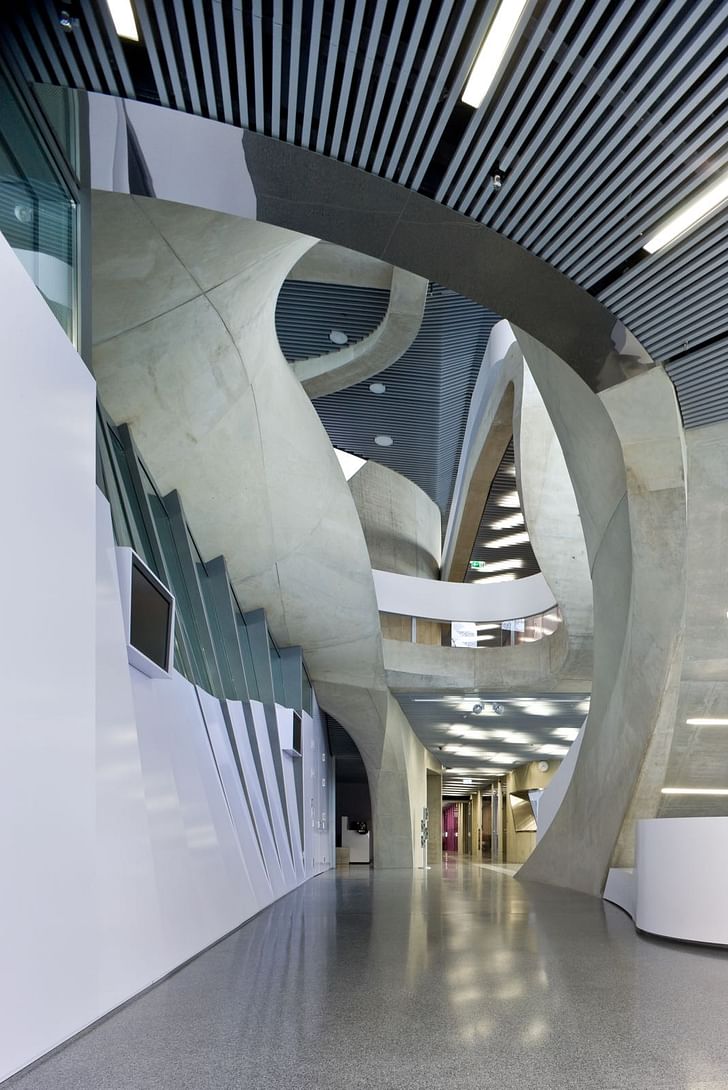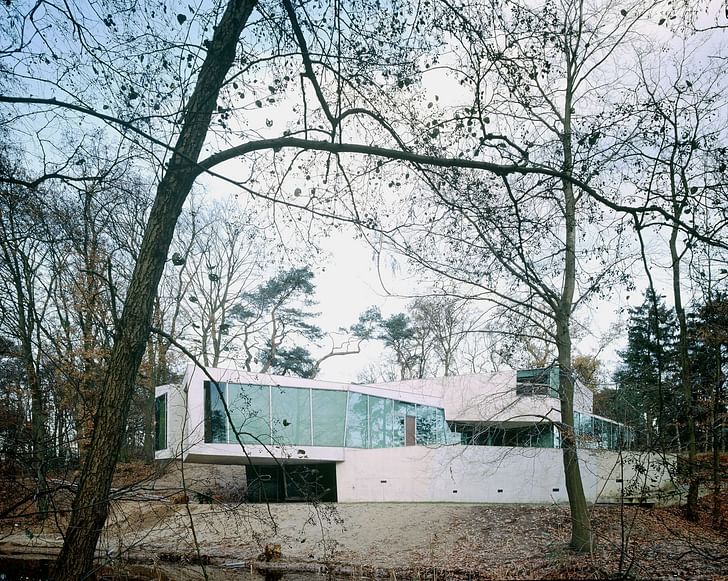

The fifth issue of LOBBY, the Bartlett School of Architecture at University College London's publication of thematically related essays and interviews, explores the meaning, fragility, and ultimate worth of a unifying architectural "faith."
The concept of "faith" has been used to justify any number of acts, whether that act is pursuing one's own aesthetic vision or carrying out a massacre. For this reason, faith has always had a somewhat murky connotation; it can lead to greatness just as surely as horror. That's partly why issue number faith has always had a somewhat murky connotationfive of LOBBY is examining faith within architecture, specifically its value as a philosophy, its tendency to stagnate when unchecked, and its likely future construction within the discipline. Essays like "Past Style: Architecture as a Sect" and "Empty but Full: Death, Solitude, and Le Corbusier" reside in this issue next to pieces such as "Leave/Stay: It's All Fucking Grey (A Terrible Account of Uncertainty)." For this edition of Screen/Print, Archinect is featuring "Moving Architecture" by LOBBY section editor and Italian architect Gregorio Astengo, an interview Astengo conducted with Caroline Bos of UNStudio.


Can architects really become the complex, open-minded and adaptable figures we need them to be? Caroline Bos talks to LOBBY about the dynamic, relational and far-reaching architectural ideas which have inspired the pioneering designs of UNStudio.
Speaking with Caroline Bos leaves one with the impression that buildings, no matter how still they may seem, are actually all about motion and change, constantly evolving and adapting to our unstable needs. Nearly three decades of experience in the field later, this mission still identifies Bos’s role in architecture as Principal Urban Planner of UNStudio—the Dutch world-renowned practice she founded with architect Ben van Berkel. After meeting in London in 1988 they began working in Amsterdam as Van Berkel & Bos Architectuurbureau. Ever since then, the unique global expansion of their practice has followed a steady and uniquely successful progression. In 1998 it became UNStudio. And in 2009, UNStudio Asia was founded, with its first office in Shanghai, shortly followed by a second office in Hong Kong in 2014. This ‘evolutionary’ trajectory, unfolding over the past 28 years, mirrors the profound awareness of the time and space of a world-wide architecture, which marks UNStudio’s all-encompassing programme.

In fact, with more than 120 projects all over the globe—including the awarded Mercedes-Benz Museum (2000-2006), Arnhem Central (1996-2015) and Singapore University (2010-2015)—UNStudio is possibly the truest example of what architecture can become once it embraces its worldly dimension. In turn, Caroline Bos can be described as the embodiment of that earthly preoccupation which defines her practice. For her, architecture needs to constantly search for innovative means of expression, it has to be analytical and empirical, serious and playful, operative and theoretical, global and local. Architecture must always look out there for new and unexplored territory to conquest. But according to Bos, it must also keep looking inside of itself, investigating that profound intimacy and relevance that still makes us believe in it.

You came into architecture from a training in history of art and urban studies. Did the intellectual environment of London and Utrecht in the 80s drive your interests and shape the role that you now have in UNStudio?
Living, working and studying in London in the 80s has indeed been deeply formative to me. In actual fact though—academically—I have consistently done everything the other way around. When I acquired my first degree in History of Art at Birkbeck College, I was already writing—together with Ben van Berkel—for Dutch newspapers and magazines. We wrote pages and pages on the cultural milieu of London and about all the great architects we met or heard about at the Architectural Association, like Zaha Hadid, Daniel Libeskind and Coop Himmelblau, just to name a few. Caroline Bos can be described as the embodiment of that earthly preoccupation which defines her practiceSome even subsequently got their first small commissions in the Netherlands! Then, some 10 years ago, I went on to study for my degree in urban and regional planning, feeling I needed some different analytical tools. So when I finally qualified as a planner, I had been already practicing for quite a while. At that time, Deconstructivism—and Derrida specifically—dominated the discourse. Ben and I were also very impressed by Paul Feyerabend’s Against Method. I would say that my second main influence came through Ben and his experiences at the AA. From that I took a strong belief that real change, real newness, can be brought about. That’s important to believe not just in an experimental approach, but also in architecture: something really new can happen, and there can be true paradigm shifts.

How does your attention to, both, the broader cultural realm and the experimental aspect inform your relationship with van Berkel?
Both of us have a profound appreciation for the other’s talents. I enormously admire Ben’s design-focused, creative and also very intuitive approach, which is strongly centered on architecture and art—of which he, of course, is also very knowledgeable. My approach, on the other hand, is somewhat broader and analytical. These two different ways of experiencing architecture are always deeply integrated. To me, that’s the core of our approach in UNStudio. Even if we come from very different places we always find a way of superimposing our methods, to combine and match our ideas.
How has the way you and van Berkel developed UNStudio relate to the architecture culture of the Netherlands?
On a personal level, I’m friends with many of my Dutch colleagues, such as Mecanoo's Francine Houben and Nathalie de Vries, as well as many others; in a way, it’s a small field and everyone knows each other well. At the same time, however, today we are all locked into our own worlds and an active debate seems to be missing. Much of the excitement that we experienced in the 1990s, when Dutch architecture was going through a boom, certainly feels less intense today. The attention of our culture has shifted to other parts of the world and this is perhaps why we are now more individually focused on our own development. On the other hand, the balances of the world as a whole have shifted so dramatically and we see diverse and truly inspiring approaches.

How can your design philosophy—which you claim is focused on tangible social realities—provide a future vision for the user to be inspired by today?
For me, the problems that architects need to tackle cannot be as politically identified as they often are. Our language is architectural and we need to express our projects, our ideas and our programmes through that language. It can’t just be words and good intentions. Our challenge is really to bring life to our built environment and we can only do it through the language of architecture. Recently, Alejandro Aravena has very explicitly positioned a social agenda onto the architectural discourse. With his Biennale, he has brought forward a way of thinking about architecture which comes less from a design-driven point of view, tending to locate the problems that architects need to tackle cannot be as politically identified as they often aresocial problems onto the public realm. I think this is very exciting because it’s a new way of looking at architecture and it could really bring a paradigm shift—inspiring and new. But for that to happen, we also need to see how this agenda inspires and innovates the discipline itself. The same goes for sustainability, for instance. What we acutely need now is to deeply internalise such positive social and ecological ideologies in the very heart of our discipline. Radically experimental and all-encompassing plans can propose alternative ways for people to live and move. They’re a fantastic way to shatter tired patterns formed by risk-avoiding institutionalism and corporatism.
How can such inspiration shape the architects’ faith in their own profession? And in return, how can architects then restore such faith for its users?
Faith—what a challenging notion! I have a lot of faith in architecture in general. I’ve seen how over the past 15 or 20 years architecture has become fantastically vibrant, more dynamic than ever. Grey cities have been enriched by so much beautiful—I use this taboo word deliberately here—architecture, made with passion and love, skill and knowledge of our profession. This I believe to be truly inspiring, for users as well as architects.
The skills and abilities developed in UNStudio—by so many talented people—have allowed us to share our insights with the users of our architecture. We have always tried to evoke their deep, visceral responses rather than focusing exclusively on functional aspects. But the profession does undergo shifts, changing on a fairly regular basis—being affected as it is by so many social, economic and political issues, alongside its own internal forces. In this sense, I would say that faith is a fundamental necessity. I would say that faith is a fundamental necessityYou need to firmly believe that the profession can not only accommodate or absorb change, but that it can really grow from it, improve and progress with every twist and turn. You also need to take risks, have confidence and believe that you can play a role in that development. With respect to the users of our work, we can only restore their faith if we take every challenge head on. If we continue to demonstrate the relevance of architecture, even the joy of it, regardless of how the profession may expand or contract, then I believe we have a good chance of inspiring faith in what we do. Faith requires patience, persistence—and yes, also some luck.

The success of UNStudio is strongly linked to your commitment towards an experimental approach, but also towards theoretical awareness. How do you mediate between these two realms?
Well in a word, it’s whirlwind. It’s always been a whirlwind, for the whole 28 years of our work in UNStudio. Sometimes I can’t even keep track of it! Our profession is under an incredible pressure and it comes from every direction, including technology, which often becomes an incredibly expansive burden. The challenge is to always be truly invested in what we do, but at the same time to stay light on our toes. The mediation is really between the commitment to an idea and the continual exploration of different forms of architectural thinking out there, starting from our own fascinations. To me, this is what can really bridge theory and practice. In a sense it’s almost like a game that we’re playing throughout our life. I think this playfulness is the most important part, and I would recommend everyone to be flexible, free, interested. This is how architecture can really reinvent itself.

Screen/Print is an experiment in translation across media, featuring a close-up digital look at printed architectural writing. Divorcing content from the physical page, the series lends a new perspective to nuanced architectural thought.
For this issue, we featured LOBBY's fifth issue, "Faith".
Do you run an architectural publication? If you’d like to submit a piece of writing to Screen/Print, please send us a message.
Julia Ingalls is primarily an essayist. Her work has appeared or is forthcoming in Slate, Salon, Dwell, Guernica, The LA Weekly, The Nervous Breakdown, Forth, Trop, and 89.9 KCRW. She's into it.
No Comments
Block this user
Are you sure you want to block this user and hide all related comments throughout the site?
Archinect
This is your first comment on Archinect. Your comment will be visible once approved.